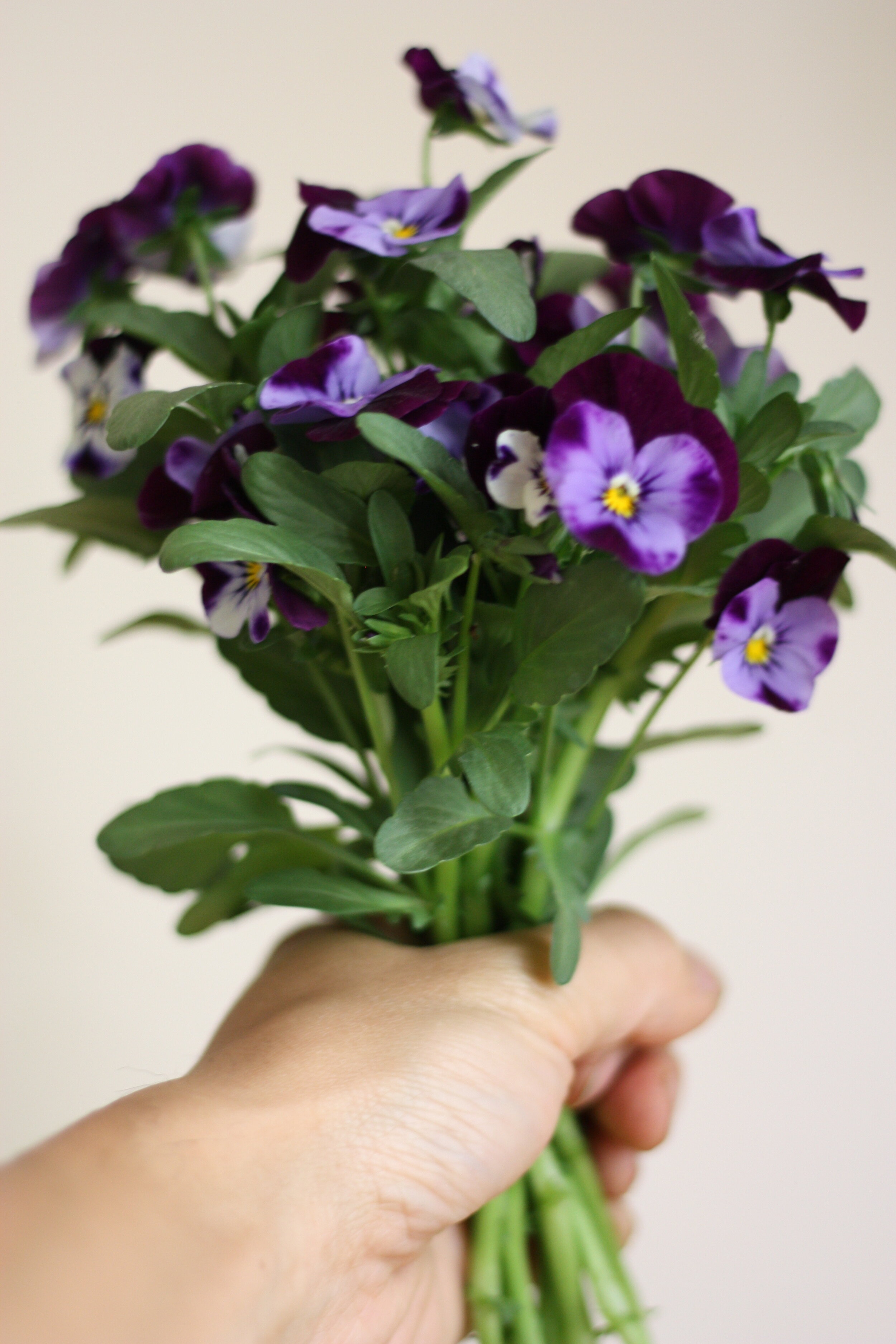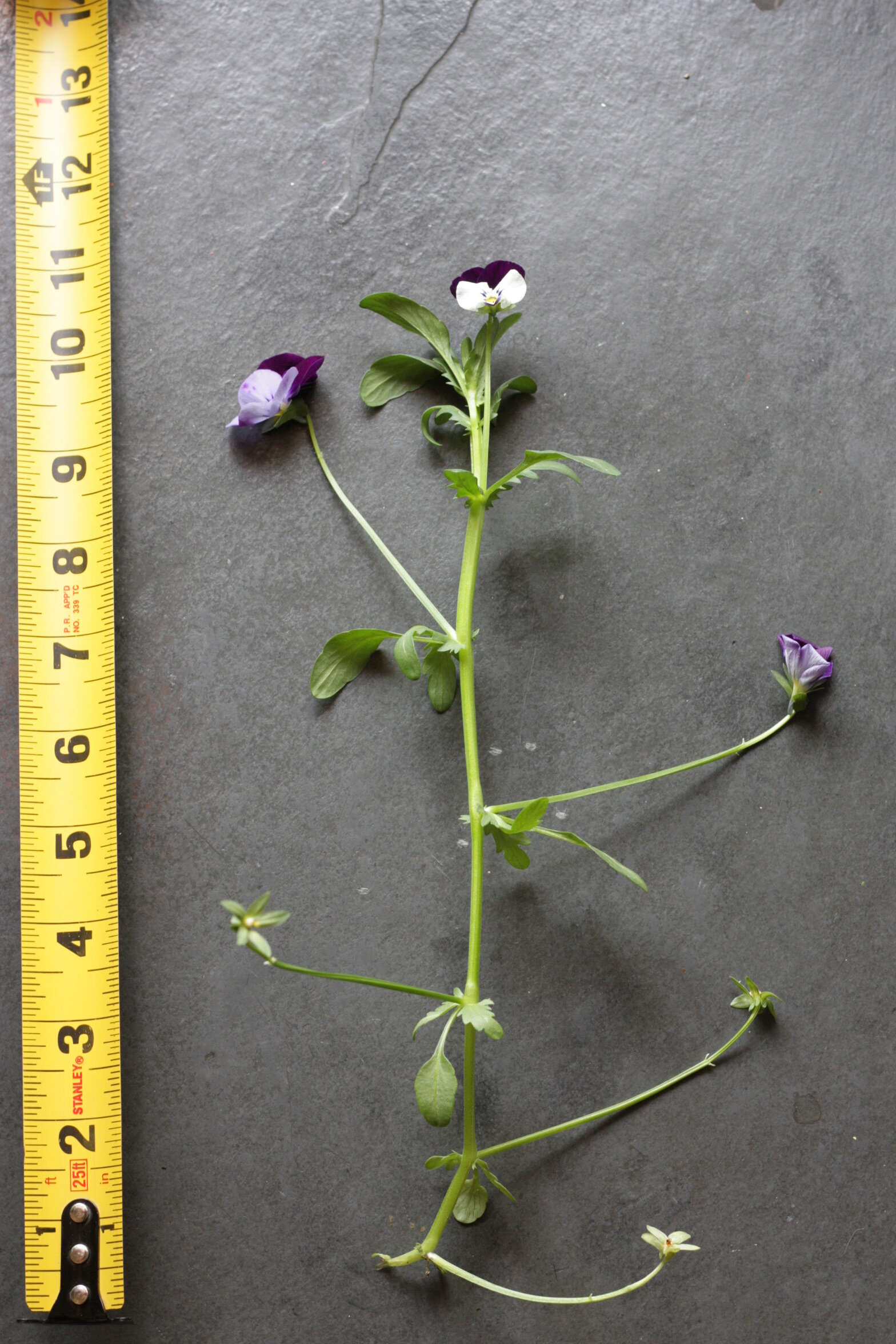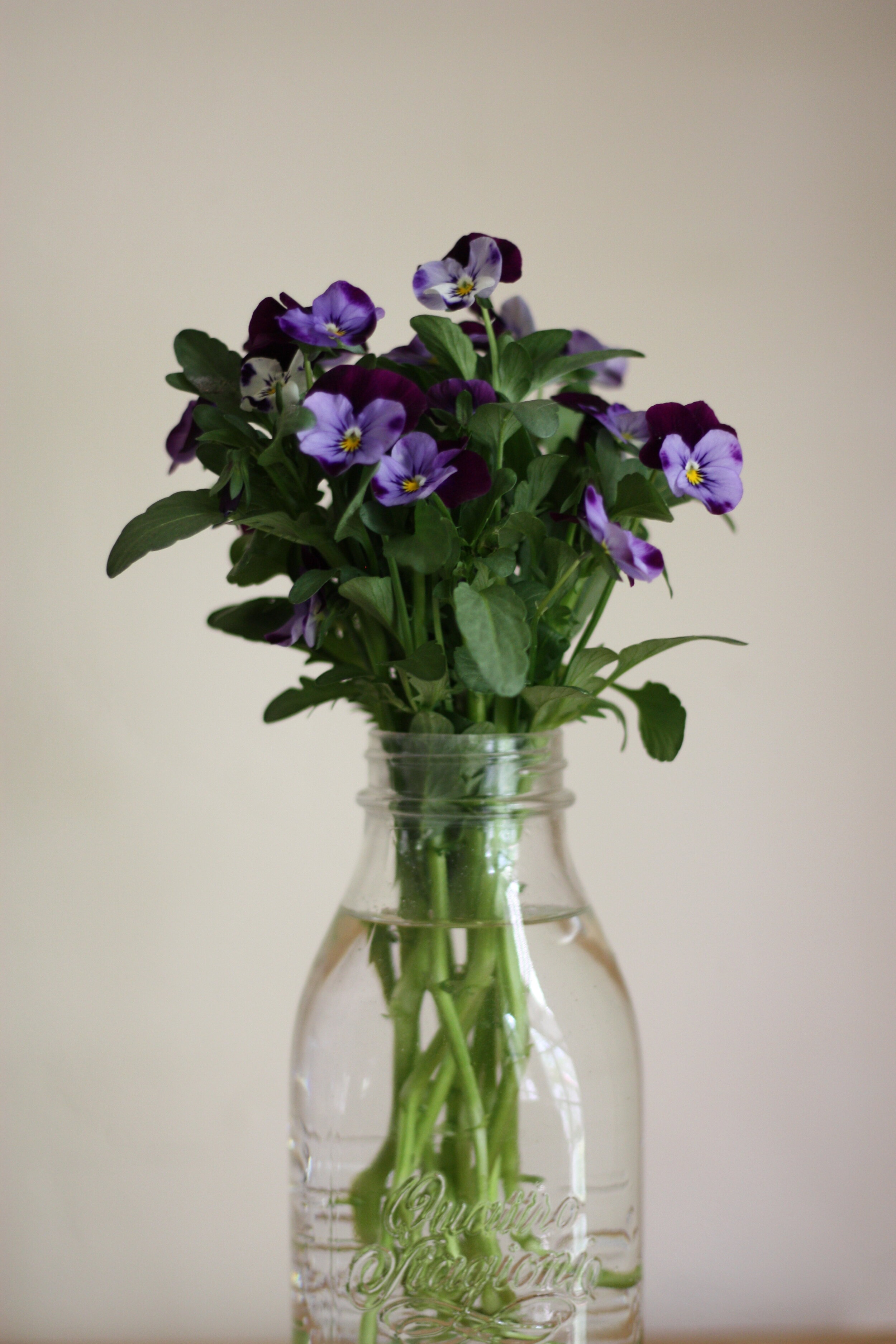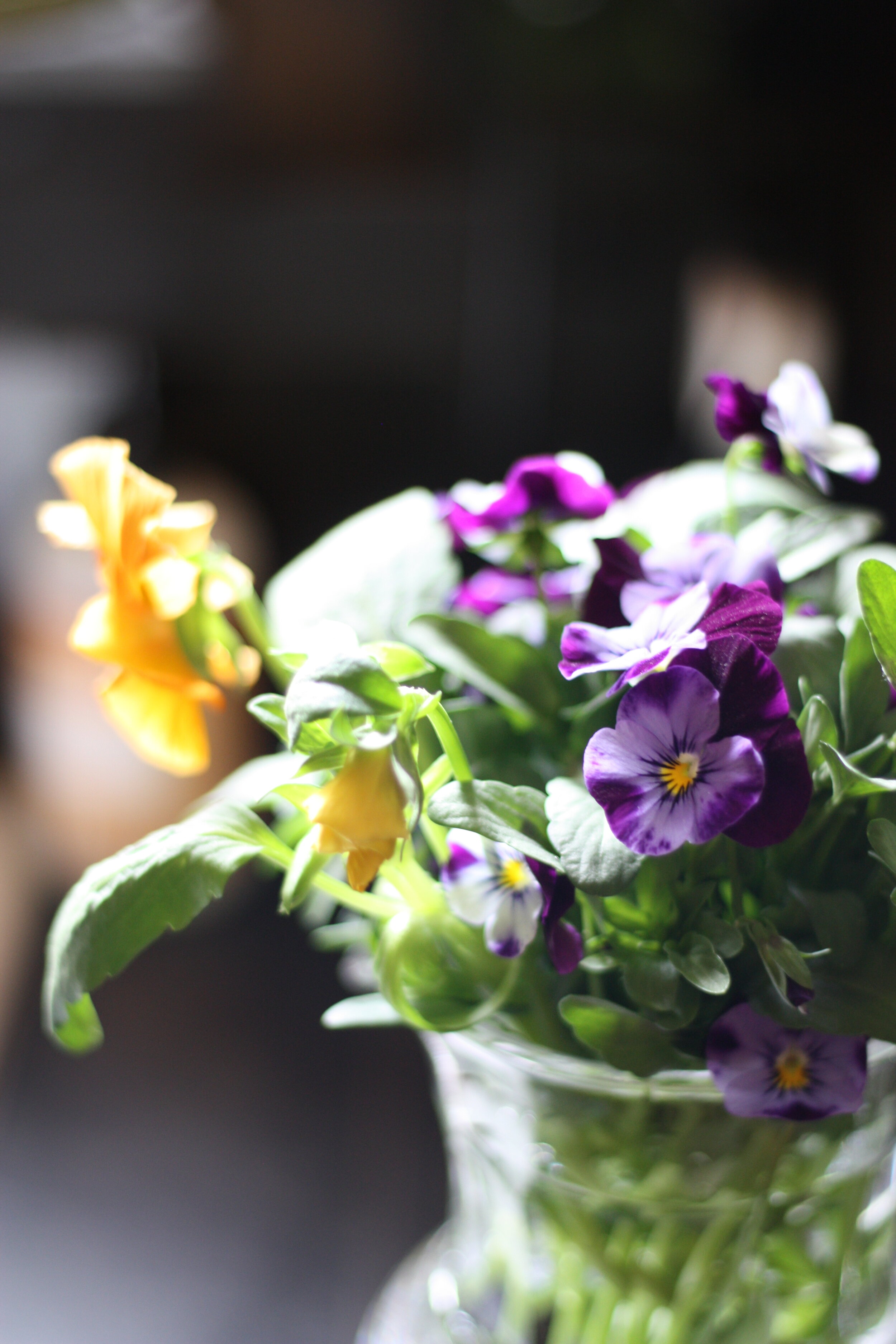Growing Violas and Pansies for the Flower Farmer
Violas and pansies are one of our favorite flowers - their bright colorful faces are such a wonderful addition to the garden and landscape, and there is of course something undeniably happy about their appearance.
When you think of violas and pansies, you generally think of the low-growing carpeted beds of boldly colored bright-faced annuals that are more commonly associated as bedding plants for shopping mall displays (that are ripped out at the end of April) or tucked into little pots and containers as a splash of color.
And we thought the same about violas and pansies - up until a couple years ago when we started noticing that floral designers such as Gabriela Salazar of La Musa De Las Flores and Max Gill started using them in their designs a few years ago, and we were intrigued at the idea of using them as a cut flower.
A beautiful arrangement by designer Gabriella Salazar of La Musa De Las Flores featuring pansies
Stunning piece by designer Max Gill featured in Martha Stewart Living. Photograph by Ngoc Minh Ngo
And ever since Erin of Floret Flower Farm performed her viola and pansy trial back in 2019, we’ve been itching to try our hands at growing them as a cut flower.
We knew that it would probably be a gamble to try and grow them here - growing a mile above sea level really shortens stem length for all flowers, and our springs are generally short and very hot, which are all non-ideal conditions for growing violas and pansies
But we decided to give it a try (and I’m glad we did!). because we wanted to see if it was possible to get them to grow as cut flowers here. If it were possible, we knew pansies and violas would be an invaluable addition to the lineup cut flowers we are able to offer in the spring - being some of the earliest and most hardy flowers to grow
And guess what?
We were successful! The main issue was with stem length, but we’ve grown them to the point where they are plenty long enough to use in design.
I’ll go over how we accomplished this below so you too can grow violas and pansies as cut flowers!
5 Important Concepts for Growing Violas and Pansies as Cut Flowers
1. Use Either a Mild Winter or a Mild Spring To Your Advantage
After doing some research, we realized that most violas and pansies don’t really get tall because they usually get removed on the last frost date to make room for the summer annuals. And to be honest, we just haven’t ever tried growing violas and pansies past mid-spring, so we were interested to see how they did here.
Most growers who have grown pansies and violas successfully tended to live in milder climates - maritime climates where temperature extremes aren’t really a thing - which isn’t the case for those of us who live further in on the continent and have greater temperature extremes. Our spring is relatively short - it’s going to be in the nineties the last week of April this year - so our window for growing violas and pansies before the heat of summer hits is a small one.
We knew we did have one advantage - our winter is mild enough that violas and pansies can be overwintered from a fall planting. This would help to get them established with good root systems prior to the heat setting in, as well as give them more vigor during the springtime to really pump energy into growing long stems and flowers.
If you don’t have a mild winter, chances are you may also have a milder spring if you live in the Northern reaches of the United States, such as Maine, Michigan, Minnesota and Montana, which you can then use to your advantage to extend out your growing season for violas and pansies.
If you live in an area where the winters and summers are very extreme, you may want to consider growing violas and pansies in a hoop house or tunnel to give yourself a longer time period to grow them out. It doesn’t necessarily need to be heated - just enough to shelter them from the worst of the winter weather.
2. Temperature and Day Length Influences Stem Length
Looking at the photo above, you can see at the bottom of the stem where the internodes of the stem are very short - only a few millimeters long in some cases, while towards the top you can see the internodes are a good couple of inches apart.
The internodal length is due to temperature and daylength - the short length internodes are created during the cold temperatures and lack of daylight in the winter, while the longer internodal lengths are created during warmer temperatures and increased hours of daylight in the spring.
If we can keep these going into the summer, we will be getting longer stem lengths - so I’m interested to see how long they can grow. We have the advantage here that our nights still remain cool well into June, so we may be able to keep growing them out until then.
3. Plant Them Closely
Similar to other cut flowers, violas and pansies should be planted really close together to create competition between the plants. When planted close together, plants will naturally stretch upwards to gain more access to light which works well for us since we want stem length to increase.
This worked well - it’s getting to the point where the stems are getting hard to harvest because they are so entangled in and among each other, but the stem length is definitely there.
We planted ours at a 3” interval, which is working really well to squish them together. Others have planted at around 4-6” intervals and gotten good results too, so you’ll have to see what works best for your growing setup.
4. Keep Them Fed
Pansies and violas are heavy feeders, greedily sucking up nutrients to power their very vigorous growth. We’re growing our violas and pansies in a soil-free medium, so we’re adding in a liquid fertilizer once a week. It’s a standard 20-20-20 because violas and pansies are such heavy feeders, but it works very well - in just the past week, they have put on two inches of height in stem length.
If you are looking to just use soil amendments, I would treat them like tomatoes or sweet peas and incorporate a lot of compost and bone meal into the soil to ensure that they get the nutrition they need. You could also do a fish emulsion or kelp fertilizer drench on a weekly basis just to ensure that they’re getting fed.
5. Be Patient
Pansies and violas will take a while to start growing - especially when first planted, they’re just going to sit there for a while. Be patient with them, keep them watered and fed, and eventually they will start growing. For us, it took two months for them to get to cutting length from transplanting plugs we ordered (and it may take you longer if you are growing them from seed).
And yes, they’ll get to 6” tall and you’ll wonder if you made a huge mistake. You haven’t, I assure you that, you just have to wait a bit longer. And a few weeks later you’ll wake up to big and long stems. It will happen, I promise you that.
I don’t recommend pinching them because you’ll want them to get as long and leggy as possible before making the first cut. Honestly, I haven’t found the lack of pinching to be an issue - as soon as I cut one stem, the rest of the plants start crowding in with more stems to cut. No deadheading is necessary either if you keep them harvested
Harvesting Violas and Pansies for Cut Flowers
Violas and pansies are pretty easy to harvest - they’re actually really hardy flowers that don’t wilt very easily. I’ve actually harvested some in the middle of a hot day, and they survived twenty minutes back into water without any effect on their vase life or performance.
You’ll want to cut down all the way at the base of the plant, which can be difficult if your plants are all tangled up. I’ll usually grab the flower with one hand and trace with a finger all the way to the base of the plant and make the cut there.
Once you’ve harvested the stem, you’re going to notice all the little stems and leaves poking off to the side. Sometimes when harvesting, these side stems can break off or bruise - that’s okay, because we’re going to be removing those anyway.
You’ll want to clean the stems all the way up to the first one or two flowers on the stem. Don’t try and leave more flowers- they’ll be harder to handle and more difficult to work with when it comes to arrangements. Give yourself a nice and clean stem, making sure to pay special attention to the leaves and stems on the bottom.
We found that we enjoyed the violas much more than the pansies - despite having smaller blooms, they grew longer stems and were far sturdier as a cut flower. I found the pansies were a bit more floppy and brittle in comparison, but were still enjoyable when used given their large faces (and great when used in combination with violas).
Get them into deep and cool water - despite them being hardy, it’s best practice to get them into water so they can get a good drank and hydrate themselves well.
Vase Life
Violas and pansies have a great vase life - averaging around two weeks! As I mentioned, they are sturdy little plants and work great as cut flowers.
One quality they have is that they don’t tend to shed their petals - the whole face just tends to slowly start curling inwards, aging gracefully instead of shattering. This adds to their overall longevity.
Additionally, the other buds on the stem will open and flower too, which also adds to their long life in a vase and adding additional interest and dimension to an arrangement.
They don’t really have any issues with hydration or staying perky in the vase. They also seem to be a relatively clean cut flower as well, not dirtying their water even after two weeks (although they do best with fresh water every couple of days, the same as any other cut flower).
Designing with Violas and Pansies
Violas and pansies are a fun material to use with floral design. If in a smaller arrangement, I like to use them as secondary flowers to contrast with a larger flower. You have to be careful when using varieties that have a distinct “eye” or “face” on them - they can be very jarring if not paired properly with their surrounding elements, and especially if used with softer more subdued color palettes I would recommend to use them more sparingly.
The two arrangements from Gabrielle and Max are both excellent examples of thinking outside the box, and both have used the color and form of the violas and pansies to their advantage. I think it really helps to view the work of others to see how you can adapt it to your own design style.
I also find that although I like mixing violas and pansies into arrangements, I really enjoy them the best on their own. There’s just something about a large massed bunch of violas that is just so enjoyable - it’s striking and different while being familiar enough for people to enjoy at the same time.
I also like pansies and violas combined together in design- although there is a difference in scale (with pansies being shorter, squatter, and fluffier compared to the slimmer, more elegant violas) they work really well together due to their similarity in growth habit and appearance.
You could do quite well selling small posies of violas and pansies in jam jars directly to customers, or even tied into little bouquets. The color is so enjoyable at this time of year with customers, and given their long vase life they will be well liked by market customers.
On the other hand, forward-thinking designers will also enjoy violas and pansies to use in their design work as well. If you’re leaning towards selling to wedding florists, I would recommend looking into some of the more subtle shades of violas and pansies that have more of the creams, ivories, blushes and rose pinks (although there is definitely a market for the black, burgundy and tiger-eye series).
I hope I’ve given you more confidence in growing violas and pansies as cut flowers!
They are honestly one of the happiest surprises we’ve had in the past five years of growing cut flowers, and I can’t wait for next spring already so we can plant even MORE violas and pansies! (Seriously, I have already designated an entire bed to growing violas and pansies for next year)
If you’re interested in learning more about growing cut flowers (for personal or professional use) you may find the following articles useful:
Nine Spring Filler and Foliages for Flower Farmers (Great for pairing with pansies and violas!)
Our Favorite Hardy Annuals - Other cut flower varieties that will grow well in the same conditions as violas and pansies for spring flowers
If you’re growing for selling pansies and violas (and other flowers) for sale, you may want to look into learning about farmer’s markets, CSA subscriptions and selling to florists.
And if you’re interested in learning more about flower farming - whether it’s growing, marketing, selling or just learning about how to get started, you can check out our Flower Farmer eBook bundle below
We are offering all seven eBooks in a bundle at a great low price for all your flower farming needs! Valued at $75+, this bundle is the perfect starter pack for the beginning flower farmer.
This bundle includes
Growing Cut Flowers for Florists
Growing Cut Flowers for Weddings
The Urban Flower Farm
The 400 Square Foot Flower Farm
Growing Dried Flowers
Growing Perennials for Cut Flowers
Floral Design for the Flower Farmer
Seed Starting for the Flower Farmer
BONUS: The Kitchen Garden (because Flower Farmers need to eat too :D )
This bundle is perfect for the beginning flower farmer, the flower farmer interested in upping their game, or someone who is wondering if flower farming is for them. Each of these books covers an aspect of flower farming in an easy and thorough manner, and will help you become successful in your flower farming ventures including selecting varieties, methods of growing, how to harvest, market, sell and connect with clients and make you successful in your business, and designing and arranging.









